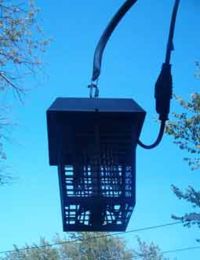Bug Zapper
A bug zapper is a device that attracts and kills insects that are attracted by light. A light source attracts insects to an electrical grid, where they are electrocuted by an exposed high voltage electrical element. more...
The name stems from the characteristic zap sound produced when an insect is electrocuted.
History
According to the US Patent and Trademark Office, the first bug zapper was patented in 1934 by William F. Folmer and Harrison L. Chapin. They were issued patent no. 1,962,439.
Design
Bug zappers are usually housed in plastic or grounded metal mesh. A light source is mounted in the middle, and is often a fluorescent lamp (designed to emit insect-attractive ultraviolet light). The light is surrounded by a pair of carefully spaced and electrically insulated charged wire grids. A voltage multiplier circuit (comprising diodes and capacitors) and/or transformer increases the voltage of a power source high enough to at least break down the dielectric formed (typically over 1,000 volts but lower voltages may be used) when an insect comes close enough to the mesh pair. An electrical arc is formed when the dielectric breaks down and current flows through the insect's body. The insect is electrocuted and then dried. An insect does not have to touch both wires, as an arc will form in an air gap over 1000 V; typically an arc will form 1000 V/mm, starting at about 1 mm.
Many bug zappers are also equipped with shallow trays that collect the remains of the electrocuted insects.
A novel variant is the manual bug zapper or electric flyswatter, which resembles a small tennis racquet strung with electrified wire. To use the device, one swats the insect, zapping it, and then collects and discards the insect.
Criticism
According to a 1996 University of Delaware study, bug zappers have effectively no effect on biting insects and cause significant damage to ecologically relevant non-biting insect populations.
Read more at Wikipedia.org



